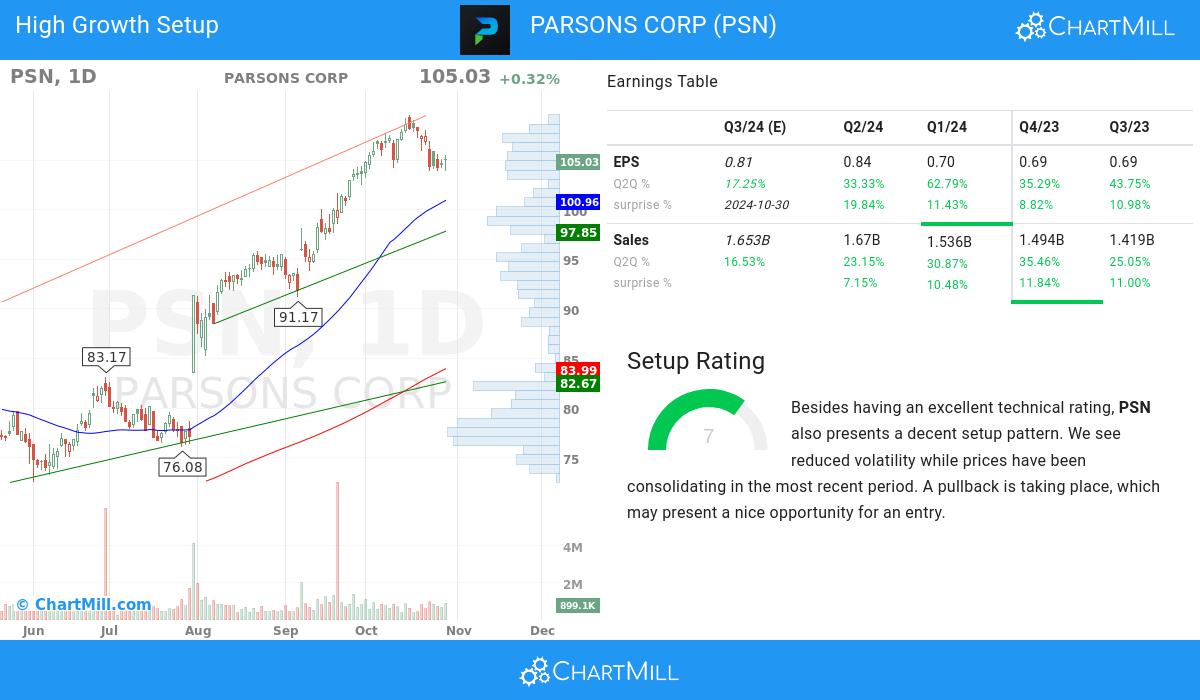NYSE:PSN: a strong growth stock preparing for the next leg up?.
By Mill Chart
Last update: Oct 30, 2024
In this article we will dive into PARSONS CORP (NYSE:PSN) as a possible candidate for growth investing. Investors should always do their own research, but we noticed PARSONS CORP showing up in our strong growth, ready to breakout screen, which makes it worth to investigate a bit more.

A Closer Look at Growth for NYSE:PSN
To evaluate a stock's growth potential, ChartMill utilizes a Growth Rating on a scale of 0 to 10. This comprehensive assessment considers various growth aspects, including historical and estimated EPS and revenue growth. NYSE:PSN has achieved a 8 out of 10:
- The Earnings Per Share has grown by an impressive 42.44% over the past year.
- The Revenue has grown by 28.35% in the past year. This is a very strong growth!
- The Revenue has been growing by 9.20% on average over the past years. This is quite good.
- PSN is expected to show a strong growth in Earnings Per Share. In the coming years, the EPS will grow by 20.81% yearly.
- The Revenue is expected to grow by 12.62% on average over the next years. This is quite good.
- When comparing the EPS growth rate of the last years to the growth rate of the upcoming years, we see that the growth is accelerating.
- The Revenue growth rate is accelerating: in the next years the growth will be better than in the last years.
Exploring NYSE:PSN's Health
ChartMill employs its own Health Rating for stock assessment. This rating, ranging from 0 to 10, is calculated by examining various liquidity and solvency ratios. In the case of NYSE:PSN, the assigned 6 reflects its health status:
- An Altman-Z score of 3.96 indicates that PSN is not in any danger for bankruptcy at the moment.
- PSN's Altman-Z score of 3.96 is fine compared to the rest of the industry. PSN outperforms 70.89% of its industry peers.
- The Debt to FCF ratio of PSN is 2.79, which is a good value as it means it would take PSN, 2.79 years of fcf income to pay off all of its debts.
- The Debt to FCF ratio of PSN (2.79) is better than 68.35% of its industry peers.
- The Current ratio of PSN (1.80) is better than 67.09% of its industry peers.
- Looking at the Quick ratio, with a value of 1.80, PSN is in the better half of the industry, outperforming 67.09% of the companies in the same industry.
Profitability Analysis for NYSE:PSN
Discover ChartMill's exclusive Profitability Rating, a proprietary metric that assesses stocks on a scale of 0 to 10. It takes into consideration various profitability ratios and margins, both in absolute terms and relative to industry peers. Notably, NYSE:PSN has achieved a 5:
- Looking at the Return On Invested Capital, with a value of 8.83%, PSN is in the better half of the industry, outperforming 63.29% of the companies in the same industry.
- The 3 year average ROIC (4.85%) for PSN is below the current ROIC(8.83%), indicating increased profibility in the last year.
- PSN's Operating Margin has improved in the last couple of years.
- PSN's Gross Margin has improved in the last couple of years.
Looking at the Setup
Besides the Technical Rating, ChartMill also assign a Setup Rating to every stock. This setup score also ranges from 0 to 10 and determines to which extend the stock is consolidating. This is achieved by evaluating multiple short term technical indicators. NYSE:PSN currently has a 7 as setup rating:
Besides having an excellent technical rating, PSN also presents a decent setup pattern. Prices have been consolidating lately and the volatility has been reduced. A pullback is taking place, which may present a nice opportunity for an entry.
Our Strong Growth screener lists more Strong Growth stocks and is updated daily.
Our latest full fundamental report of PSN contains the most current fundamental analsysis.
Our latest full technical report of PSN contains the most current technical analsysis.
Disclaimer
This article should in no way be interpreted as advice. The article is based on the observed metrics at the time of writing, but you should always make your own analysis and trade or invest at your own responsibility.
